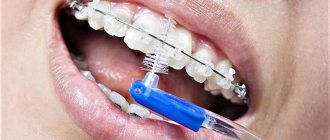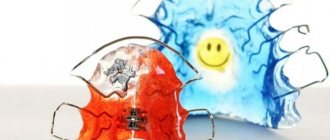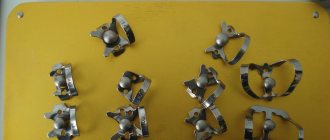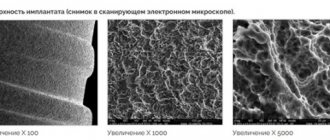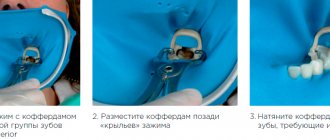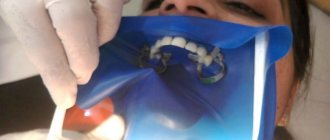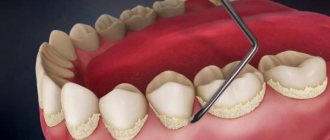Rubberdam (cofferdam) - protective dental screen (gasket) made of latex: with its help, the doctor isolates the teeth being manipulated from the rest of the oral cavity. This ensures the sterility of the working area during root canal treatment, restoration of broken teeth, prosthetics (crowns and bridges), installation of veneers, etc.
Rubberdam is a stretchy elastic napkin 5x5 or 6x6 centimeters made of latex or nitrile (for patients with latex allergies). Some dentists prefer brightly colored sheets to increase light in the work area. Others choose dark materials so that the tooth stands out against their background.
What is hidden behind complex names and when to use these tools
Today it is difficult to argue with the fact that in dentistry the level of development of advanced technologies has made it possible to significantly improve the quality of services and bring them to a fundamentally new level. But not all patients clearly understand that dental treatment or restoration largely consists of many little details that are invisible to the average person, each of which is individually important and irreplaceable.
For example, a rubber dam in dentistry. Having heard about it, many believe that this is just another way to extract money from a patient, and do not even suspect that the product can bring significant benefits and contribute to achieving the most positive result. How? Read about this in the material prepared below.
Alternatives
The main role of the rubber dam is to ensure the isolation of the tooth from possible moisture. Traditionally, this is solved using cotton rolls that are placed around the tooth. But they have to be changed frequently, they interfere with the dentist’s view and cause discomfort to the patient.
A more modern option is saliva absorbent pads (Dry Tips) . They have greater absorbency and fit more comfortably in the mouth. But their insulating characteristics are still inferior to rubber dam.
For timely removal, a saliva ejector is used . But its use requires the constant presence of an assistant. This device takes up a certain place in the mouth and can interfere with the dentist’s work.
The following isolation methods are less often practiced:
- retraction thread;
- fum tape;
- liquid rubber dam;
- Tofflmayr matrix holder with metal matrices;
- sectional matrices and wooden wedges.
Learn about the advantages of the device and one of the application methods from the video.
What is a rubber dam?
So, rubber dam in dentistry - what is it? Take a look at the photo. This is a latex plastic material. The doctor first places it on the patient’s oral cavity before starting treatment, after which he makes the necessary hole to isolate the working area under one, sometimes several teeth. That is, in essence, it allows you to isolate the working field, remove all unnecessary things that may interfere.
The specialist fixes the device using a special frame or clamps, ensures the required level of lip tension and gets to work.
On a note! Have you heard about optidam in dentistry, but have no idea what rubberdam and rubber dam are? It will be useful for you to know that these are the same thing, the only differences are in the names and their translation from English. But the essence of these devices is the same - to ensure sterility and isolation of the working field.
General overview
A rubber dam is a material with which the dentist isolates a diseased tooth during treatment.
Most often this term refers to a piece of latex with a hole. In fact, this is a broader concept, since in addition to standard 15x15 cm flaps, there are also rolled forms of rubber dam, three-dimensional latex plates, as well as its liquid version.
The invention is not new at all. Dental treatment using this technology was first performed in the mid-19th century. Who owned the original idea is a moot point, since both the Frenchman La Roche and the American Sanford Christie Burnim claimed authorship.
One way or another, but since 1867, rubber dam (from the German Kofferdam) or rubber dam (English version Rubberdam) have entered the practice of dentists everywhere.
The traditional material for rubber dam is cis-1,4-polyisoprene, obtained from the sap of a tropical plant - Hevea brasiliensis.
Nowadays, International Rules for performing a number of dental procedures require the mandatory use of a rubber dam.
Cofferdam: long-forgotten old or new in dentistry
A rubber dam or dental rubber dam allows dental treatment to be performed quickly, reliably, and conveniently. But not everyone knows that this device is not a trend of progress at all, but a long-forgotten old one. Thus, the product was first presented to the public more than 100 years ago. It was invented by an American dentist: in those days the system was successful, but was gradually forgotten by doctors. This happened because it did not directly affect the outcome of treatment, plus it increased material costs. Therefore, only a small part of doctors were ultimately inclined to use it, and then it was used only for endodontic treatment.
Today, increased demands are placed on sterility and quality of work performed. Plus, innovations have appeared - restorations using modern materials, whose quality and perfection are steadily growing - which was not the case before. All this requires a high degree of preparation, which is why the rubber dam in dentistry has again gained popularity.
Our doctors
18 years of experience
Baghdasaryan
Armen Evgenievich
Chief physician, dentist-orthopedist-therapist
Graduated from VSMA named after. N.N. Burdenko. Internship on the basis of MGMSU named after. A.E. Evdokimov in “General Dentistry”.
Clinical residency at the Moscow State Medical University named after. A.E. Evdokimov in “Orthopedics”.
More about the doctor...
5 years experience
Sadina
Ekaterina Vladislavovna
Dental therapist, surgeon
Penza State University Medical Institute, specialty “Dentistry”.
In 2016, she underwent professional retraining in the specialty “Therapeutic Dentistry” at the Moscow State Medical and Dental University named after A.I. Evdokimov.
More about the doctor...
Indications and scope of application of rubber dam
In what areas of dental services is rubber dam installation used:
- Endodontics: This branch involves treating the root canals of a tooth. And here it is very important not only to maintain perfect sterility, but also to prevent medicinal compounds from getting into the surrounding mucous membrane of the patient, so as not to cause an allergic reaction. It is also important to protect the area from liquids, i.e. saliva,
- light fillings and artistic restorations: for high-quality adhesion of the composite and photopolymer to the walls of the tooth, their adhesion, the condition of the absence of moisture, foreign liquid, saliva must be observed, which ensures the device,
- enamel whitening: the purpose of the rubber dam in this case is to protect the mucous membrane from the temperature effects of lamps, chemical bleaches,
- fissure sealing,
- splinting of teeth.
Pros for dentists
Using a rubber dam makes the dentist's job much easier as it provides good visibility and access even in hard-to-reach areas of the mouth. Other benefits are as follows:
- There is no need to be distracted by auxiliary manipulations in the form of removing liquid or replacing cotton swabs, since the area is reliably protected from blood, saliva and other liquids;
- The risk of infection and contamination of the working area with pathogenic organisms is eliminated, therefore risks such as relapse of caries or infection during dental canal treatment are practically reduced to zero;
- Improving the quality of prosthetics and installation of fillings, their durability by eliminating the entry of biological fluids into the working area, which reduce adhesion.
Benefits of use for the doctor and patient
The use of a rubber dam in dentistry brings great benefits to both the doctor and the patient. Let's look at which one.
For the doctor: the ability to concentrate on work, convenient access to the desired tooth, improved visibility of the working field, dryness, cleanliness, sterility. The doctor can also easily monitor the condition of the tooth and the mucous membrane around it, stopping bleeding in time and carrying out disinfection. He spends his time rationally and can do without additional devices - a saliva ejector, cotton sponges.
For the patient: applying Optidam allows him to feel protected and not worry about the doctor injuring the lips, adjacent teeth, gums, mucous membranes, and the inside of the cheeks. A person can easily swallow saliva, because it will not harm the treatment process, and besides, medications, instrument fragments, and foreign impurities will not get into it. You also won’t have to spit or rinse your mouth often. Muscles and joints get less tired, because... treatment time is reduced. All this creates a feeling of some comfort.
Purposes of application
Working with a rubber dam in dentistry is the key to protection against cross-infections and the confidence that the inflammatory process from a tooth during its treatment will not spread to neighboring ones. In addition, the installed filling or restoration will last much longer than it would have without the use of latex protection. After all, this ensures the dryness of the working space, and if saliva and breath vapors get inside, the adhesion of the filling material would be much less, and the treatment would be more effective.
It turns out that the main goal is to improve the level of quality of service, save in the long term, and be able to maintain the health of the oral cavity, teeth and gums.
Advantages
Cofferdam has a lot of advantages. Its use is preferable for both medical personnel and patients.
Benefits for the doctor:
- The field of work is as open as possible, providing a high-quality view of all surfaces of problem areas, which facilitates manipulation;
- there is no need to control salivation, timely replacement of cotton wool rolls and use of a saliva ejector;
- there is additional protection for medical personnel from possible patient infections;
- harm from natural processes (coughing, sneezing, direct breathing) is minimized, which contributes to maximum adhesion of materials to the tooth surface;
- the patient does not have the opportunity to engage in inappropriate conversations.
Benefits for patients:
- the mucous membranes of the oral cavity are protected from the influence of sharp instruments and caustic liquids for disinfection and rinsing - there is no physical damage, the risk of allergic reactions is reduced;
- the possibility of foreign objects (tooth fragments, crown particles, miniature dental instruments, filling material) and infections getting into the pharynx and respiratory tract is prevented;
- the tongue is protected, but at the same time is in a natural position, which does not load the masticatory muscles, does not make it difficult to swallow saliva and makes it easy to endure long-term treatment with an open mouth;
- a possible gag reflex is suppressed, since the rubber dam protects the palate.
The most important advantage of using a rubber dam is a significant increase in the quality of work performed.
Fillings last longer, and the likelihood of re-inflammation of the root canals due to infection during treatment is minimal.
Let's figure out together why teeth hurt and what can be done in such a situation.
Get acquainted here with the features of the classification of caries according to ICD 10.
At this address https://www.vash-dentist.ru/lechenie/zubyi/effektiven-li-analgin-ot-boli.html we will tell you how to take Analgin for toothache.
Disadvantages and contraindications
The application of a rubber dam in dentistry is contraindicated for people with nasal breathing problems, because If isolation is applied to the mouth, such a patient will have difficulty breathing. They are not suitable for people prone to epileptic seizures, with Alzheimer's disease, or with allergic reactions to latex, rubber, or talcum powder.
As for the disadvantages of use, they also exist: an unprofessional doctor can spend quite a lot of time installing the device, and it can touch and injure the interdental papillae. This procedure cannot be done without an assistant or assistant. It is best to install a latex napkin in four hands. Also, the doctor may have difficulty selecting the shade of the tooth to be restored with direct restorations, because the rest of the dentition in this case is hidden under the cloth.
Well, and most importantly, this, although slightly, increases the total cost of treatment. But as studies show, 99 patients out of 100 patients would agree to the use of such measures even taking into account the increase in price - but doctors do not always offer it, and patients do not know about this.
Rubberdam. New quality standard?
Rubber dam in dentistry.
For many patients, the word rubber dam or rubber dam (synonyms) is new. What kind of device is this and why does the dentist use it? This is what today's article is about.
It’s no secret that dentistry has taken a noticeable “step forward” over the past few years. New technologies are replacing old ones, new companies are entering the market, equipment is being improved, materials are becoming more aesthetically pleasing and durable. There is a lot of money in dentistry (despite the crisis), so progress is inevitable and that’s great. On the one side. On the other hand, such a rapid change of generations of “equipment” requires the doctor to keep his finger on the pulse all the time, monitor the latest events, trends, and know how to apply these innovations in his practice in order to make it better . And do no harm.
Composite materials (composite “ light fillings ”) appeared in our country in the early 90s, if I’m not mistaken, and the use of composites began to gradually become widespread. Why did it happen so?
Before composites, teeth were filled with cements (phosphate, glass ionomer, etc.) or amalgam . These are good materials that have proven themselves, but cements and amalgam had a number of disadvantages, which subsequently led to the transition of most dentists to composite materials. It was difficult or impossible to model anatomy with cements; some of them caused toxic and thermal effects on tooth tissue during “hardening”; it was necessary to make some kind of insulating and “therapeutic” “gaskets”. Amalgam was also not completely biocompatible and easy to use (not to mention aesthetics). In addition to all this, the materials of the “past generation” required classical preparation; usually, for this, the doctor had to excise not only caries, but also healthy tissue in order to create retention points to hold such a filling. All undercuts (overhanging edges) were also ordered to be eliminated - otherwise there was a high risk of fracture.
Why are dentists happy to switch to “light fillings”? Firstly, of course, aesthetics . Nobody wants a metal filling, everyone wants a “white” one :) Secondly, compared to amalgam and cements, it was much easier to work with a composite. There is no need to mix or knead anything, the consistency of the composite made it possible to model it as much as you wanted, and then “illuminate” it with a lamp and the filling is ready! You don’t need to wait 2 hours to eat, the filling is beautiful, you don’t need a second visit for polishing, as with amalgam. All in all, a fairy tale.
But not everything turned out to be so simple. In addition to the composite itself, this technique of filling (restoring) teeth also uses an adhesive system . Her role was greatly underestimated by dentists, because... this has never been done before. In simple terms, the adhesive system is the “glue” that “sticks” the composite filling to the surface of the tooth tissue. This “glue” has a very complex chemistry (and over the years it becomes more and more complex) and the process of “gluing” the filling to the tooth is influenced by many factors. And one of the main factors is the cleanliness of the working area. That is, the absence of any “polluting” factors (blood, saliva, food plaque, etc.), including moisture. In order for the “seal” to “stick”, it must not only be clean, but also dry . Otherwise, the fillings “fall out”, “darken”, teeth hurt after treatment, thin walls break, etc. With proper adhesive restoration techniques , the tooth does not need to be over-prepared to create “retention points” and “additional sites” to “hold” the filling in place. This is a big advantage of composite materials, coupled with their biocompatibility and aesthetics. But often doctors “ don’t believe ” in adhesion (gluing) and prepare teeth “the old fashioned way,” as for cement or amalgam fillings. But that's half the trouble . If the conditions for carrying out the adhesive restoration technique are violated, the composite often behaves worse than cements and amalgam, which leads to complications even faster than in the case of using “old materials”. Pain after treatment, “falling out” fillings, wall fractures, secondary caries - this is most often the result of a violation of the technique of using the composite and the adhesive system. After the emergence of many complications, many doctors even became skeptical about composite restorations.
Great introduction. But without it, you would not be able to fully appreciate the significance of such a simple, but at the same time irreplaceable device as a rubber dam.
Rubberdam (eng. rubber - rubber, dam - barrier) is a system for isolating the working field in dentistry. Rubber dams are latex scarves that are fixed to the teeth with special metal clamps, “ clamps .” Oddly enough, rubber dam is not a newfangled “gadget” in the dental market. The technology is quite old and is already almost 150 years old ! This system was invented by the American dentist Sanford Christie Barnum in 1864. Why are we returning to this technology now? And why was she “forgotten”? The answer lies in my voluminous introduction. The reason is a change in technology . Rubberdam, which appeared on the market a century and a half ago, was very popular among dentists, but its popularity gradually faded away, because... The rubber dam had an indirect effect on the outcome of tooth filling, and required effort, time and financial costs for installation. Therefore, the rubber dam was used by a small number of doctors (in general, as it is now, unfortunately) and only for endodontic treatment. Now this isolation technique has again become in demand with the advent of adhesive technology for dental restoration and adhesive fixation of ceramic restorations, because adhesion is more demanding on the cleanliness of the working field.
In addition to ensuring absolute dryness of the working field, the rubber dam also prevents contamination (infection) of tooth tissues by oral microorganisms, which is of no small importance in root canal treatment. If you go for an X-ray of a tooth during treatment (with instruments or to check the filling of canals) without a rubber dam , saliva inevitably gets into the tooth and root canals, and with it, possibly, food plaque, which contains tons of microorganisms. This does not always lead to negative consequences, because... our body is a perfect system that is quite difficult to damage irreparably, but in combination with other factors, this can lead to chronic inflammation, destruction of bone tissue and ultimately even tooth loss . Cleanliness is the key to health. This also applies to root canals, oddly enough :)
not all agree that the use of rubber dam in endodontics is justified , but far fewer dentists agree in the treatment of caries They are more willing to believe in miraculous “healing pads” (which, I am sure, are not necessary) than in the advisability of isolation. But in my opinion, the use of rubber dam in the treatment of caries is more than justified , because dentin has a “porous” structure, and can also be easily infected by microorganisms, and this is an important factor when the cavity in the tooth comes quite close to the pulp chamber (deep caries, so-called).
All of the above applies to the treatment of children . But rubber dams in pediatric dentistry are the exception rather than the rule, unfortunately. It’s not customary for us to bother with primary teeth, and if a child has already erupted permanent teeth and they have caries, then at the “children’s appointment” there is usually no time for a rubber dam\it’s not necessary\I don’t know how/the child can’t handle it, etc. d. Hence the problems with teeth and bite at the age of 18-25 years, because most often the chewing teeth (first molars, “6s”), which erupt first, are affected, and these are the “keys of occlusion,” the most important teeth for full chewing. They are the first to be removed at a young age, most often.
Fortunately, more and more doctors (especially young ones) are beginning to use the rubber dam system to isolate teeth. This undoubtedly improves the culture and efficiency of our treatment. Rubber dam is a simple and affordable tool that every specialist involved in the treatment and reconstruction of teeth must own. It is not surprising that the rubber dam is accepted as a quality standard in the world's recognized dental communities. Rubber dam is not only a necessary standard for daily practice and improves the quality of treatment, but also comfort for both the doctor and the patient. Many doctors who do not use rubber dams say that it is “inconvenient” for their patients. But my daily practice (as well as research by scientists) shows the opposite: 99 patients out of 100 are absolutely not against a rubber dam, moreover, many even feel more comfortable with it.
The benefits of using a rubber dam are simple and clear. Why then do most doctors not use it in their daily practice at all, or use it on major holidays? The answer is quite simple: laziness and unwillingness to work better today than yesterday. Think about this when choosing your doctor and your child's doctor.
I hope in this article I was able to clearly talk about the “new old technology” called rubber dam, what it is needed for and when it is used. Thank you for your attention! Health to you and your teeth! :)
Khaldin Alexander Sergeevich
Types and properties of rubber dams
- a classic of the genre: the classic dental rubber dam is made of rubber, which comes in different thicknesses and densities. The most popular option is the average value up to 0.23 millimeters; they are universal for any medical manipulation. Thick and extra-thick are mainly used for gum retraction - their density ranges from 0.29 to 0.38 millimeters. Also, sometimes individual optids are made on special orders when certain conditions must be met,
- liquid rubber dam: it is based on a helium component, which, when applied, spreads evenly and polymerizes under the influence of light, hardens in the interdental spaces and on the gums. It is lightweight and easy to use. The main scope of application is whitening, removal of dental plaque and calculus during professional hygiene, an additional measure of protection in combination with a rubber dam during endodontic treatment of canals.
The color of the device also matters:
- light shades: for example, light beige is suitable for treating and filling tooth canals. The material in this shade turns out to be almost transparent, which makes it possible to perform high-quality tooth restoration and determine its exact position, direction, and shape. Blue, pink, marble colors of rubber dam can also be used for these purposes - but they are used less often,
- dark shades: green, gray, blue are used in restorations and allow you to determine the color, shape, and condition of adjacent elements of the dentition to select the desired shade.
Liquid material
Rubber dam in the form of methacrylate gel is a good solution for many dental procedures.
First of all, it is easy to apply, effectively isolates the gums, penetrating into the most difficult interdental areas.
The method of applying it is as follows: retractors are placed in the oral cavity to move the cheeks and tongue, a saliva ejector is inserted and the working surface is dried using cotton rolls.
Then the periodontal tissues are covered with a gel, which polymerizes in 20 seconds. The patient is ready for further manipulations. The protective material is removed with careful movements using a special trowel.
Since the liquid version does not protect the entire oral cavity, its main areas of application are:
- professional enamel whitening;
- microabrasion.
Liquid rubber dam is used when additional protection is needed for gums covered with a classic latex curtain.
What tools does a doctor need to fix the rubber dam?
The installation of a rubber dam in dentistry should be carried out by a specialist using special auxiliary tools: a stencil or template (marker) to accurately determine the location of the tooth and select the place where the hole needs to be made. The doctor will also need a punch - this is a tool that will help make a cut on the latex sheet. The doctor must also have special fastening elements, fixing the rubber sheet: frame, staples and clamps (they differ depending on which tooth should be treated - there are types for upper and lower molars, premolars, central teeth and roots) clamps, floss and dental floss.
Types of rubber dam.
Classic rubber dam.
This is a latex napkin, which in turn varies in density and thickness. Depending on the purpose, a certain type is used. There are also differences in colors that determine the scope of application. The colors are: light beige, blue, pink, green, gray, blue.
Liquid rubber dam.
Made on a gel basis, when used it tends to be distributed evenly and is fixed when exposed to special light. This type of rubber dam is used for teeth whitening, sometimes in combination with endodontics (canal treatment).
Free consultation
Startsmile experts are leading dentists in Moscow. Doctors at our aesthetic dentistry center SDent are among the leading specialists in the field of dentistry throughout Moscow.
More details
SDent in the TOP 10 best dental clinics in Moscow A place of honor in the ranking of private dental clinics in Moscow in 2022 by the expert magazine about dentistry Startsmile with the support of Kommersant Publishing House
More details
AT THE GERMAN AESTHETIC DENTISTRY CENTER ES-DENT, specialists provide a guarantee for dental treatment and are responsible for the long-term quality result, ensuring the most comfortable condition of the patient during the treatment procedures. That is why the use of a rubber dam has positive aspects for both the patient and the doctor.
How does a doctor install a rubber dam?
There is absolutely no need to be afraid of the procedure. There are even several rubber dam techniques that a doctor can use depending on the situation.
- "Wings". This option involves the use of a frame and a clamp; it is designed to work with molars and premolars.
- Work in tandem with an assistant. In this embodiment, the doctor cannot do all the work himself; he needs the help of a person who will hold the insulating sheet on the frame. The doctor himself will fasten the clamps. Ideal for working with any teeth.
- The work begins with installing a clamp on the tooth, and only then the latex scarf and frame are applied.
- Arc method. Used when it is necessary to treat the lower teeth. It can be quite sensitive, so your doctor will administer anesthesia before using it.
While the complexities of installing the curtain and its nuances can only be understood by a professional, the process of removing the protective material is very easy and simple: when working with one tooth, after removing the clamp, the latex is easily removed. When treating several elements of the dentition, it is removed using special scissors.
Purpose
Despite the long history of rubber dam, its use in ordinary Russian dental offices is extremely rare.
And where this technology is used, most patients react skeptically to the proposal to install a latex curtain in the oral cavity. However, after treatment with a rubber dam, it is difficult not to appreciate all its benefits.
The use of a rubber dam serves the following purposes:
- maintaining sterility and dryness of the working surface , i.e. saliva and blood should not get on the teeth and root canals;
- preventing the patient from swallowing medications , dental instruments, filling material, and possible pathogenic bacteria that multiply in the thickness of the pulp;
- protection of the field of dental manipulations from contact with the tongue and the inner surface of the cheeks;
- improving visibility of the tooth being treated;
- simplifying access to problem areas;
- preventing possible fogging of the dental mirror.
It is important to understand! The rubber dam is used to improve the comfort of treatment and the highest quality of work. It does not limit the process of swallowing saliva and nasal breathing, so it does not cause discomfort!
In the video, a specialist will talk in more detail about the purpose of the rubber dam.
